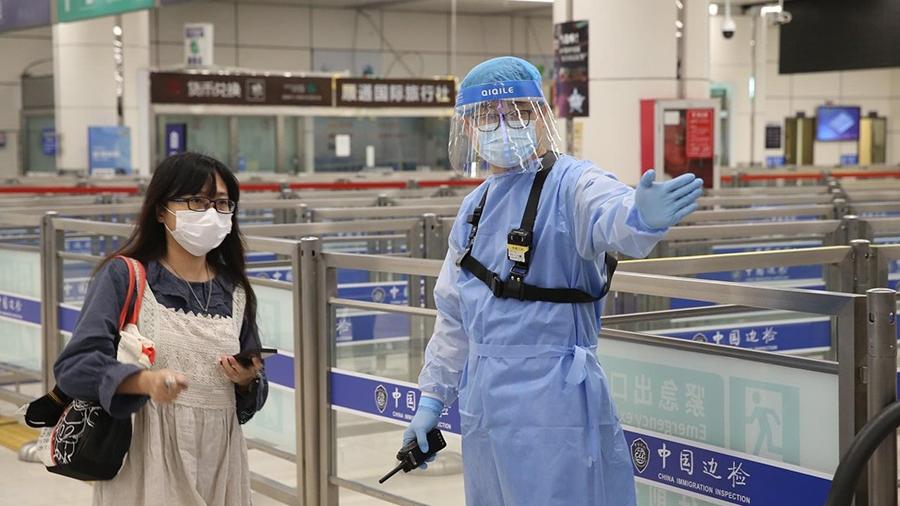 A traveler passes a checkpoint on the border between Hong Kong and the Chinese mainland. (PHOTO PROVIDED TO CHINA DAILY)
A traveler passes a checkpoint on the border between Hong Kong and the Chinese mainland. (PHOTO PROVIDED TO CHINA DAILY)
Hong Kong saw a surge of people crossing the boundary to the Chinese mainland in the hope of clearing quarantine before the Chinese New Year, as Shenzhen toughened its rules for inbound travelers effective today.
From Dec 28 through Sunday, nearly 25,000 people have left Hong Kong via three checkpoints — Shenzhen Bay, the Hong Kong-Zhuhai-Macao Bridge, and the Hong Kong airport — up 23 percent from the previous week.
Among them, nearly 17,000 people, overwhelmingly Hong Kong residents, headed north via the Shenzhen Bay checkpoint. On Sunday alone, 3,607 people left the city via the sole land boundary crossing open to travelers between the two cities, outnumbering the last peak on Dec 2 since the fourth wave of the COVID-19 outbreak started in mid-November.
ALSO READ: HK residents flock to mainland amid virus wave
Starting Tuesday, travelers are required to present their booking records for a hotel room for two weeks of quarantine before entering Shenzhen, in addition to acquiring a negative test result issued within the past 24 hours.
There was no washroom where I was waiting, and I dared not to drink or eat. It was really frustrating.
Mao, a 31-year-old Hong Kong resident who left the city on Sunday
A resident surnamed Mao left Hong Kong via Shenzhen, for its neighboring city Huizhou, on Sunday. He spent roughly six hours waiting at Shenzhen Bay and an extra four hours before being transferred to a Huizhou hotel.
“There was no washroom where I was waiting, and I dared not to drink or eat. It was really frustrating,” said the 31-year-old, who attributed the long wait to a lack of workers checking documents at counters on the Hong Kong side at the boundary crossing.
Cathy Xu, a 22-year-old graduate student from City University of Hong Kong, had a similar plight on Monday when she spent four and half hours at Shenzhen Bay without eating or drinking. Before that, she was caught in a traffic jam near the checkpoint, and it took a half-hour to make a journey that would normally take seven minutes.
After 14 days of quarantine in Shenzhen, Xu will also undergo seven days of quarantine at her hometown in Hunan province for the Chinese New Year and take online courses for the next semester until May.
Well-prepared, Lin Jiafei, 30, spent only an hour at Shenzhen Bay on Monday, as she arrived at the checkpoint early in the morning to avoid long lines.
Lin left for Shenzhen to take care of her art education business. She will return to her hometown in Sichuan province for the Lunar New Year, where she could face another round of quarantine mandated by local authorities.
READ MORE: Mainland, HK experts exchange views on pandemic situation
Meanwhile, the Hong Kong government extended the city’s anti-coronavirus curbs through Jan 20, citing a slow decrease in daily caseloads and the possibility of a rebound after all the holiday gatherings over the past two weeks.
The suspension of face-to-face classes at the city’s kindergartens and primary and secondary schools, originally scheduled to end Jan 10, was also extended until after the Lunar New Year holidays in mid-February.
Primary and secondary schools can arrange half-day classes, but the maximum number of pupils returning to campus is capped at one-sixth of a school’s total.
Current social distancing rules, mostly in force since Dec 10, include a ban on dining at local restaurants after 6 pm, a ban on public gatherings of more than two people and the shutdown of entertainment venues, such as bars, beauty salons and theaters.
Announcing the decision on Monday, Secretary for Food and Health Sophia Chan Siu-chee said the rules are “not very likely” to be loosened before the Chinese New Year.
“The number of new infections is on the decline, but its rate is significantly slower than that of the last wave. There are still risks of new cases rebounding. Large-scale cluster outbreaks also occurred occasionally,” Chan said.
“Meanwhile, after fighting the virus for months, residents are abiding less by social distancing rules. A lot of people were seen on the streets over the past several holidays.”
Hong Kong recorded 53 new COVID-19 cases on Monday, including 43 local infections of which six were untraceable, bringing the city’s tally to 9,017.
Contact the writers at jefferygu@chinadailyhk.com


